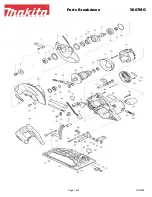
English
22
.
q. Do not operate the power tool near
flammable materials.
Sparks could ignite
these materials.
r. Do not use accessories that require
liquid coolants.
Using water or other
liquid coolants may result in electrocution
or shock.
KICKBACK AND RELATED WARNINGS
Kickback is a sudden reaction to a pinched or
snagged rotating wheel. Pinching or snagging
causes rapid stalling of the rating wheel which
in turn causes the uncontrolled power tool to
be forced in the direction opposite of the
wheel's rotation at the point of the binding.
For example, if an abrasive wheel is snagged
or pinched by the workpiece, the edge of the
wheel that is entering into the pinch point can
dig into the surface of the material causing the
wheel to climb out or kick out. The wheel may
either jump toward or away from the operator,
depending on direction of the wheel´s move-
ment at the point of pinching. Abrasive wheels
may also break under these conditions.
Kickback is the result of power tool misuse
and/or incorrect operating procedures or con-
ditions and can be avoided by taking proper
precautions as given below.
a. Maintain a firm grip on the power tool
and position your body and arm to
allow you to resist kickback forces.
Always use auxiliary handle, if pro-
vided, for maximum control over kick-
back or torque reaction during start-up.
The operator can control torque reactions
or kickback forces, if proper precautions
are taken.
b. Never place your hand near the rotating
accessory.
Accessory may kickback over
your hand.
c. Do not position your body in line with
the rotating wheel.
Kickback will propel
the tool in direction opposite to the wheel’s
movement at the point of snagging.
d. Use special care when working cor-
ners, sharp edges etc. Avoid bouncing
and snagging the accessory.
Corners,
sharp edges or bouncing have a tendency
to snag the rotating accessory and cause
loss of control or kickback.
e. Do not attach a saw chain woodcarving
blade, segmented diamond wheel with
a peripheral gap greater than 10 mm or
toothed saw blade.
Such blades create
frequent kickback and loss of control.
f. Do not “jam” the wheel or apply exces-
sive pressure. Do not attempt to make
an excessive depth of cut.
Overstressing
the wheel increases the loading and sus-
ceptibility to twisting or binding of the
wheel in the cut and the possibility of
kickback or wheel breakage.
g. When wheel is binding or when inter-
rupting a cut for any reason, switch off
the power tool and hold the power tool
motionless until the wheel comes to a
complete stop. Never attempt to
remove the wheel from the cut while
the wheel is in motion otherwise kick-
back may occur.
Investigate and take
corrective action to eliminate the cause of
wheel binding.
h. Do not restart the cutting operation in
the workpiece. Let the wheel reach full
speed and carefully re-enter the cut.
The wheel may bind, walk up or kickback
if the power tool is restarted in the
workpiece.
i. Support panels or any oversized work-
piece to minimize the risk of wheel
pinching and kickback.
Large work-
pieces tend to sag under their own weight.
Supports must be placed under the work-
piece near the line of cut and near the
edge of the workpiece on both sides of
the wheel.
j. Use extra caution when making a
“pocket cut” into existing walls or other
blind areas.
The protruding wheel may
cut gas or water pipes, electrical wiring or
objects that can cause kickback.
ELECTRICAL SAFETY
When using electric machines always observe
the safety regulations applicable in your coun-
try to reduce the risk of fire, electric shock and
personal injury. Read the following safety
instructions and also the enclosed safety
instructions.
7062477-THOR-800W-Ma-1712-07.indb 22
22-03-18 11:27
















































